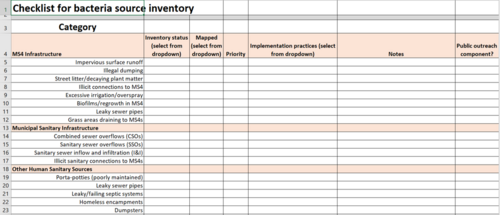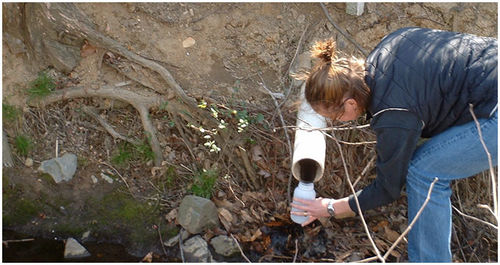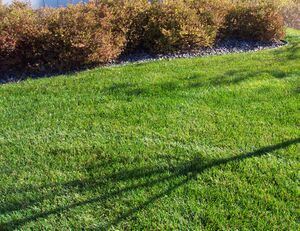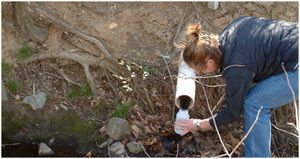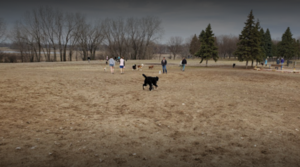
Support document for Checklist for bacteria source inventory Revision as of 15:56, 17 December 2020 by Mtrojan (talk | contribs) (→MS4 Infrastructure - Street litter/decaying plant matter)
Page in development
The MPCA, working with stakeholders, developed a checklist for conducting an inventory of bacteria sources. The checklist is not a permit requirement but may be used to meet permit requirements 22.3 and 22.4. This page provides guidance and supporting information for the checklist.
Contents
- 1 Link
- 2 Structure of the checklist
- 3 Supporting information
- 3.1 MS4 Infrastructure - Impervious surface runoff
- 3.2 MS4 Infrastructure - Illegal dumping
- 3.3 MS4 Infrastructure - Street litter/decaying plant matter
- 3.4 MS4 Infrastructure - Illicit connections to MS4
- 3.5 MS4 Infrastructure - Excessive irrigation/overspray
- 3.6 MS4 Infrastructure - Biofilms/regrowth in MS4
- 3.7 MS4 Infrastructure - Leaky sewer pipes
- 3.8 MS4 Infrastructure - Grass areas draining to MS4s
- 3.9 Municipal Sanitary Infrastructure - Combined sewer overflows (CSOs)
- 3.10 Municipal Sanitary Infrastructure - Sanitary sewer overflows (SSOs)
- 3.11 Municipal Sanitary Infrastructure - Sanitary sewer inflow and infiltration (I&I)
- 3.12 Municipal Sanitary Infrastructure - Illicit sanitary connections to MS4s
- 3.13 Other Human Sanitary Sources - Porta-potties (poorly maintained)
- 3.14 Other Human Sanitary Sources - Leaky sewer pipes
- 3.15 Other Human Sanitary Sources - Leaky/failing septic systems
- 3.16 Other Human Sanitary Sources - Homeless encampments
- 3.17 Other Human Sanitary Sources - Dumpsters
- 3.18 Other Human Sanitary Sources - Trash cans
- 3.19 Other Human Sanitary Sources - Garbage trucks
- 3.20 Domestic pets - Dog parks
- 3.21 Domestic pets - Dogs, cats, etc. residential
- 3.22 Urban wildlife - Rodents/vectors
- 3.23 Urban wildlife - Birds/bird congregation areas (gulls, geese, pigeons)
- 3.24 Urban wildlife - Open space
- 3.25 Other urban sources - Landfills
- 3.26 Other urban sources - Food processing facilities
- 3.27 Other urban sources - Outdoor dining
- 3.28 Other urban sources - Restaurant grease bins
- 3.29 Other urban sources - Bars/stairwells (washdown areas)
- 3.30 Other urban sources - Road construction
- 3.31 Other urban sources - Piers/docks
- 3.32 Urban non-stormwater discharges - Power washing
- 3.33 Urban non-stormwater discharges - Car washing
- 3.34 Urban non-stormwater discharges - Pools/hot tubs
- 3.35 Urban non-stormwater discharges - Reclaimed water/gray water
- 3.36 Recreational sources - Bathers/boaters
- 3.37 Recreational sources - RVs (mobile)
- 3.38 Agricultural sources - Livestock/manure storage
- 3.39 Agricultural sources - Livestock, pasture
- 3.40 Agricultural sources - Livestock, corrals
- 3.41 Agricultural sources - Livestock (CAFOs)
- 3.42 Agricultural sources - Manure spreading
- 3.43 Agricultural sources - Municipal biosolids reuse
- 3.44 Agricultural sources - Reclaimed water/gray water
- 3.45 Agricultural sources - Irrigation tailwater
- 3.46 Agricultural sources - Slaughterhouses
- 3.47 Other sources - Grazing
- 3.48 Other sources - Streambank erosion
- 3.49 Other sources - Wildlife populations
- 3.50 Other sources - Other (describe in notes)
- 4 Related pages
Link
Link to the checklist: File:Checklist for bacteria source inventory.xlsx
Structure of the checklist
The checklist contains four worhsheets.
- Information
- Checklist
- Useful links
- Dropdowns
These are discussed below.
Information worksheet
This sheet provides basic general information about the checklist.
Checklist
This is the sheet where users enter information. Column A contains different categories of bacteria sources and specific sources within each category. The categories include the following.
- MS4 infrastructure
- Municipal sanitary infrastructure
- Other human sanitary sources
- Domestic pets
- Urban wildlife
- Other urban sources
- Urban non-stormwater discharges
- Recreational sources
- Agricultural sources
- Other sources
Columns B through G are where users input information.
- Column B: Inventory status. The user chooses from a dropdown list containing the following options - Completed, On-going, Planned this permit cycle, Not planned for this permit cycle, Not applicable. Completed means the practice has been fully implemented. On-going means the practice is being implemented but is not fully implemented. The two options pertaining to permit cycle only apply to MS4 permittees.
- Column C: Mapped. The user chooses from a dropdown list containing the following options - Yes, No, Partly. If a user has mapped or partially mapped the practice, consider describing the type of mapping in the Notes section (e.g. GIS).
- Column D: Priority. The user chooses from a dropdown list containing the following options - low, medium, high. The user indicates if the activity is a low, medium, or high priority.
- Column E: Implementation practices. The user can select a specific practice from a dropdown list or enter a user-specified value. The options are Water quality monitoring, Installation of pet waste bags, Elimination of over-spray irrigation, Street sweeping, Infiltration BMPs, Waterfowl management, Other, and NA (not applicable).
- Column F: Notes. The user can provide additional information in this column.
- Column G: Public outreach component. The user selects from a dropdown list with the options Yes or No. This applies to MS4 permittees who are attempting to meet Minimum Control Measures 1 or 2.
Filling out this checklist fulfills permit requirements 22.3 and 22.4, as long as Columns B, C, D and E are completed. However, if the sources are not mapped, then an inventory (i.e. address of a dog park) needs to be documented.
Supporting information
This section provides some basic information about each of the potential sources included in the checklist. Where appropriate we include links where additional information can be found.
MS4 Infrastructure - Impervious surface runoff
Runoff from impervious surfaces typically contains high concentrations of bacteria. The impervious surface, however, is not the source of the bacteria; it is the conveyance mechanism.
Ultimately the source of bacteria in urban stormwater is animal waste. Identifying the specific source is more challenging and likely varies with location and land use. Typical sources include domestic pets and wildlife, particularly birds. Sources of bacteria to receiving waters include urban stormwater runoff, leaking sewer lines, sewer overflows, septic systems, landfills, marinas and pumpout facilities, poorly operating packing plants, and other illicit discharges.
Some general observations from the literature are summarized below.
- Fecal coliform levels are considerably lower (about 90 percent lower) in runoff that occurs in winter compared to summer months (Selvakumar and Borst, 2006)
- Bacteria levels can increase sharply during snowmelt events
- Bacteria concentrations in runoff increase as percent imperviousness increases up to about 20 percent impervious, but are unaffected by further increases in impervious surfaces
- Residential lawns, driveways, and streets are the major source areas for bacteria, while rooftops and parking lots are usually smaller source areas. Irrigated lawns, in particular, are high contributors
- Sartor and Gaboury (1984) reported nearly 92 percent of the bacteria originated from streets in the residential-institutional land-use site, whereas only about 33 and 19 percent of the bacteria originated from streets in the industrial and commercial land-use sites
- Bannerman et al. (1993) reported that 78 percent of the fecal coliform bacteria load for one of the same residential land-use study subbasins studied by Waschbusch et al. (1999) originated from streets
- In areas with pet waste ordinances and education, pet wastes are likely to be a minor contributor to bacteria (Burnhart)
| Land use | Median (MPN/ml) | Maximum (MPN/ml) |
|---|---|---|
| Commercial | 6900 | 350000 |
| Industrial | 9700 | 290000 |
| Residential | 20000 | 600000 |
| Rooftop | 1250 | |
| Open space | 4500 | |
| Forested | < 100 |
Sewage typically contains fecal coliform concentrations in excess of one million most probable number per 100 milliliter (MPN/100 ml). This is about two orders of magnitude greater than urban stormwater concentrations. General indicators of bacteria sources include the following.
- Higher concentrations in baseflow compared to stormwater runoff indicate sewage or other illicit discharges
- Elevated concentrations in winter indicate sewage or other illicit discharges
- Elevated concentrations during dry weather conditions indicate sewage or other illicit discharges or runoff from lawn irrigation
- Very high concentrations indicate sewage or other illicit discharges
A complicating factor is that bacteria can survive and grow both within the storm sewer system and within receiving waters. Growth within the storm sewer systems includes both the surface and subsurface conveyances. For example, coliform bacteria have been found to survive and grow in moist soils and leaf piles. A recent study in Minneapolis indicated that catch basins are an important source, largely as a result of growth within the catch basin.
The following table provides a summary of data from the literature. Maximum concentrations are included to illustrate the tremendous variability that may occur in bacteria concentrations. The values represent a compilation of data from several sources (see references at the bottom of this page).
The following links go to tables providing management strategies for different bacteria sources.
- Residential prevention practices for bacteria
- Municipal practices pollutant controls
- Industrial prevention practices for bacteria
MS4 Infrastructure - Illegal dumping
Overview:RV dumping or leaking into the storm drains, particularly at vacation destinations, can contribute bacteria and pathogens to the storm sewer system, either by directly dumping into storm drains or by dumping onto impermeable surfaces that drain to the storm sewer system. Illicit RV dumping can be managed by providing public education on appropriate practices, publicizing RV dump locations, by proving a citizen’s reporting hotline, and by publicizing fines PATHOGENS in Urban Stormwater Systems. For an example of an RV dumping brochure, see the brochure “Think Blue San Diego”.
Where/when is this a concern: There are limited direct bacteria sources associated with illegal dumping (e.g. diapers, pet waste). However, illegal dumping of organic material (e.g. yard waste, oil) can act as a food source for microbes in the storm sewer system.
Management strategies:
- Education, such as through schools and through community awareness groups, about the costs and dangers incurred by illegal dumping.
- Create safe, public-friendly waste disposal options and advertise them.
- Create laws that impose stiff fines for the perpetrators and advertise these stiff fines.
Suggested references: No specific references recommended. Conduct a web search for more information.
MS4 Infrastructure - Street litter/decaying plant matter
Overview
Street litter and plant material indirectly contribute to bacteria loads by providing a food source and habitat for bacteria populations to survive and grow. A study in the Minnehaha Creek Watershed, Minnesota, indicated organic material is an important contributor to bacteria in stormwater runoff.
Where/when is this a concern
There are few studies that specifically focus on street debris as a source for bacteria. This is likely to be an important source during times of the year when organic debris is in streets and temperatures and moisture conditions are conducive to bacterial growth. Spring and early fall are therefore the most likely times for this to be an important source of bacteria.
Management strategies
Pollution prevention and source control practices, such as street sweeping, are recommended to control street litter and plant material. This table provides a summary of additional practices for residential areas, many designed to control sources of organic material to the storm sewer system.
MS4 Infrastructure - Illicit connections to MS4
The United States Environmental Protection Agency defines an illicit discharge as, “any discharge into a storm drain system that is not composed entirely of stormwater.” The Minnesota Municipal Separate Storm Sewer System (MS4) General Permit defines illicit discharge as any discharge to a municipal separate storm sewer that is not composed entirely of stormwater except discharges pursuant to a NPDES permit (other than the NPDES permit for discharges from the municipal separate storm sewer) and discharges resulting from firefighting activities.
There are many potential illicit discharges to an MS4. The concern here are sources that contribute bacteria and pathogens, or that contribute pollutants that may promote bacteria and pathogen growth (e.g. organic sources). The most important potential sources are likely to be sanitary sewer connections, including broken sanitary sewer lines where septage seeps into a storm sewer line, cross-connections, and and straight pipe discharges. These sources contribute high concentrations of bacteria and pathogens to the storm sewer system.
Many illicit discharges occur during dry weather when storm flows are not contributing, or are intermittent. This may aid in detecting illicit discharges, since storm sewer discharges during dry weather or intermittent discharges may indicate the presence of illicit discharges. There are several techniques for detecting illicit discharges, including outfall monitoring, use of tracers (e.g. smoke, dye), and use of electronic equipment (e.g. cameras). More specific information on some illicit discharges and methods for identifying them are found in the sections oncombined sewer overflows, sanitary sewer overflows, inflow and infiltration, and illicit connections to sanitary sewers.
Stormwater practitioners and managers covered under the MS4 General permit must develop and implement an illicit discharge detection and elimination (IDDE) program. Information on permit requirements is found here.
For more information, see the following documents.
- Illicit Discharge Detection and Elimination: A Guidance Manual for Program Development and Technical Assessments - Center for Watershed Protection
- The Basics of Illicit Discharges - EPA
- MCM 3 Illicit Discharge Detection and Elimination - Minnesota Stormwater Manual
MS4 Infrastructure - Excessive irrigation/overspray

Irrigation runoff is an allowed discharge to storm sewer systems, provided there are no illicit pollutants in the discharge. Irrigation runoff can contribute bacteria and pathogens to runoff and mobilize sources within the storm sewer system. In particular, irrigation runoff is a potentially important source of dry weather flows in residential and commercial areas. A study in the Minnehaha Creek Watershed, Minnesota, indicated over-irrigation and subsequent runoff from lawns was an important source of bacteria. A study in San Diego indicated a higher frequency of runoff in residential areas compared to commercial land uses. An Alabama study indicated wet-weather samples having mostly higher enterococci levels than E. coli, while dry weather source area samples (such as springs and irrigation runoff) had higher E. coli levels (Shergill and Pitt, 1984). The contribution of dry weather inflows from irrigation runoff has also been known to foster in-situ bacterial growth (Geosyntec 2010).
The primary focus on reducing inputs from irrigation should focus on reducing overirrigation. Effective methods to reduce irrigation runoff include development of educational outreach, increased inspections, fines for overwatering, tiered water rates, provide irrigation controller rebates or distribution of smart irrigation controllers and/or other financial incentive programs that decrease watering volume (Geosyntec 2012). A residential runoff study in Orange County conducted in five neighborhoods found dryweather runoff decreased by 50% in areas where weather-based irrigation controllers were installed (IRWD and OCMWD 2004). Berg et al. (2009) found dry-weather runoff reductions of 25% to 50% for a similar study of 4,100 Smart Timers installed in residential and commercial areas. Promoting better irrigation runoff management also reduces water waste and can improve water quality.
MS4 Infrastructure - Biofilms/regrowth in MS4
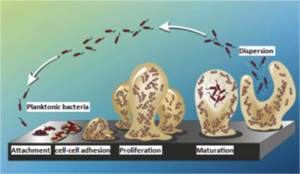
Regrowth of bacteria in the storm sewer system has been documented but is poorly understood. Regrowth is problematic because it may negate upstream efforts to control bacteria and pathogens. Regrowth typically occurs in biofilms. Biofilms are surface-attached communities of microorganisms that undergo cell attachment, growth, detachment, and sloughing. Biofilms are normally extremely diverse and include a wide variety of bacteria, including pathogenic bacteria. The pathogens E. coli O157:H7, Salmonella enterica, and Campylobacter jejuni are all known to form biofilms. Further, biofilm formation can favor the survival of all three of these organisms under both typical environmental conditions and under active disinfection. Biofilms act as a source of bacteria in stormwater runoff during periods of higher flow, which dislodges bacteria from the biofilms.
Factors that commonly limit the survival of bacterial pathogens in biofilms include low levels of available nutrients and organic material, non-favorable oxygen concentrations, and the competitive, antagonistic and predatory activities of the indigenous microbial population. High stormflow rates cause detachment and sloughing of biofilms. Biofilms can develop in urban storm sewer piping and in streets. Some researchers have questioned the utility of using indicator bacteria in conditions favorable for biofilm growth, since indicator bacteria survive and grown in biofilms while many pathogenic bacteria do not.
Irrigation runoff can contribute to formation of biofilms in storm sewers that can be an on-going source of bacteria discharged from the storm sewer system Green Infrastructure Implementation Strategy (2018). Other factors that may favor biofilm development include organic debris in streets, favorable surfaces for attachment within the storm sewer system (e.g. submerged aprons, particularly those constructed of concrete), and increased loading with natural sediments containing naturally occurring biofilms, stormwater enriched in bacteria. During prolonged periods between runoff events, environmental biofilms (i.e. naturally-occurring) appear to outcompete and replace biofilms consisting of bacteria originating from stormwater flows. Enhancing the storm sewer environment to favor environmental bacteria may be one approach to reducing loading of bacteria from stormwater flows.
For more information, see Urban Water Resources Research Council (2014), Roberts (2012), and Burkhart (2013).
MS4 Infrastructure - Leaky sewer pipes
Leaky sewer pipes potentially can contribute very high concentrations of bacteria to storm sewer systems. Leaking sewer systems are more common in areas with aging infrastructure, where contributions from leaking systems can be as high as 20 percent of annual flow in the sanitary sewer system. For a detailed discussion of contributions from leaking sewer systems, see Sercu et al. (2011), Vasquez-Sune et al. (2011), Yang et al. (1999), Rutsch (2006), and Prigiobbe and Giulianelli (2011)
For more information on potential effects of leaking sewer infrastructure, methods of detecting leaks, and management strategies, see the section on illicit discharges and the section on sanitary sewer inflow and infiltration.
MS4 Infrastructure - Grass areas draining to MS4s
Urban lawns and other grass areas can be a source of bacteria and pathogens to stormwater runoff. Concentrations of indicator bacteria in runoff typically exceed water quality standards in all land uses, often by more than an order of magnitude, with concentrations tending to be higher from residential areas compared to commercial, industrial, and open space land uses (Minnesota Stormwater Manual). Grass swales and grass strips typically have higher concentrations of bacteria and enterococci in outflow water compared to inflow, although if these practices infiltrate water the total loading may be decreased by the practices (International BMP Database). Contributions of bacteria to runoff from grass areas is not well understood. Hathaway and Hunt (2010) conducted a study of bacteria in runoff from residential areas in North Carolina and concluded the following.
- Concentrations of indicator bacteria are lower in winter compared to growing season months
- Concentrations of indicator bacteria are higher during wetter periods (e.g. increased rainfall, increased number of days with rain, higher soil moisture content)
- There was no or minimal first flush effect (i.e. bacteria loading is relatively constant throughout a rain event)
Practices or factors that potentially contribute to bacteria loading from grass areas include the following.
- Over-watering/irrigating
- Presence of waterfowl or other animals
- Soil compaction, leading to increased runoff
- Use of manure as a fertilizer
Practices to reduce bacteria inputs from grass areas include the following.
- Replacing grass areas with other plant assemblages, such as native perennial vegetation
- Improving infiltration in grass areas by relieving compaction and landscaping to enhance water retention
- Discouraging congregation of wildlife
- Avoiding use of manure as a fertilizer
- Pet waste management
- For swales and filter strips, enhancing infiltration or filtration
- Mowing less frequently
Municipal Sanitary Infrastructure - Combined sewer overflows (CSOs)
Combined sewer systems (CSS) are sewers that are designed to collect rainwater runoff, domestic sewage, and industrial wastewater in the same pipe. During wet weather conditions, the volume of stormwater runoff can exceed the capacity of the CSS infrastructure, including both the piping system and/or the treatment plant. This is common where where older CSS infrastructure is in place, combining sanitary and storm drain flows. When the capacity of the CSS is exceeded, excess water can bypass treatment and bypassed flow will be mixed with the treated water prior to disinfection and just prior to discharge to the receiving water. While both stormwater runoff and sanitary sewer discharges contain bacteria, concentrations are much higher in untreated sewage. Thus, CSOs can lead to very high concentrations of bacteria in water delivered to receiving waters. For more information, see [3], [4], [5], [6], [7].
Municipal Sanitary Infrastructure - Sanitary sewer overflows (SSOs)
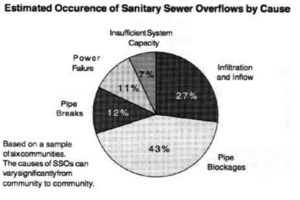
Sanitary sewer systems collect and transport domestic, commercial, and industrial wastewater. Some sanitary sewer systems may contain limited amounts of stormwater and infiltrated ground water to treatment facilities, but they are designed to carry just sewage and industrial wastewater. Occasionally, sanitary sewers will release raw sewage. These types of releases are called sanitary sewer overflows (SSOs). Possible causes of SSOs include blockages, line breaks, sewer defects that allow stormwater and groundwater to overload the system, power failures, improper sewer design, and vandalism. The adjacent image indicates line blockages appear to be an important cause of SSOs. An EPA survey indicated SSOs are most common during wet weather flows.
SSOs that discharge to surface waters are considered point source discharges and are thus prohibited unless authorized by a NPDES permit. SSOs may be indicative of improper operation and maintenance of the sewer systems, and may violate NPDES permit conditions. Effective illicit discharge and elimination practices and programs minimize the occurrence and impacts from SSOs. Other management strategies include the following.
- Sewer system cleaning and maintenance
- Reducing infiltration and inflow through system rehabilitation and repairing broken or leaking service lines
- Enlarging or upgrading sewer, pump station, or sewage treatment plant capacity and/or reliability
- Construction wet weather storage and treatment facilities to treat excess flows
For more information, see [8], [9], [10], [11]
Municipal Sanitary Infrastructure - Sanitary sewer inflow and infiltration (I&I)
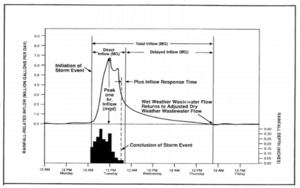
Groundwater infiltration and rainfall derived inflow and infiltration, commonly referred to as inflow, are components of most sanitary sewer systems. These inputs, called I&I, should be a minor component of the sanitary sewer flow. However, infiltration and inflow may be considered excessive when it is the cause of overflows (SSO) or bypasses in the sanitary sewer system. In addition, I&I is treated at wastewater treatment plants even though it is relatively clean water, resulting in extra cost.
EPA provides guidance for estimating the input and importance of I&I in a sanitary sewer system. To assess extraneous water entering your system at least a year of influent flow data to the treatment facility should be examined. For infiltration analysis, flow data collected during the high groundwater periods is used. For inflow analysis, the Average Wet Weather (AWW) flow can be estimated from flow data for a one week period when there has been significant rain. If a single storm event is used to analyze wet weather inflow, it should be an event large enough to cause surface ponding and runoff. Other techniques can be used to determine the presence of I&I, including manhole testing and maintenance, dye tracing, smoke testing, use of cameras, and private property inspection for improper connections. Examples of improper connections include downspouts, groundwater sump pumps, foundation drains, drains from window wells and outdoor basement stairwells and drains from driveways.
Proper evaluation of I&I sources is necessary to manage them. Once detected, they can be eliminated or minimized. Several cities, for example, have programs and ordinances prohibiting illicit connections on private property.
For more information, see [12], [13], [14], [15]
Municipal Sanitary Infrastructure - Illicit sanitary connections to MS4s
The Municipal Separate Storm Sewer System (MS4) General Permit defines illicit discharge as "any discharge to a municipal separate storm sewer that is not composed entirely of stormwater except discharges pursuant to a NPDES permit (other than the NPDES permit for discharges from the municipal separate storm sewer) and discharges resulting from firefighting activities". Not all illicit discharges contain bacteria and pathogens, but examples of illicit discharge sources containing bacteria and pathogens include sewage and septage, washwater, irrigation water, some commercial and industrial water,
Illicit discharges to the storm sewer system can be classified as direct or indirect. Direct discharges are directly connected to the storm drain pipe through a sewage pipe, shop drain, or other kind of pipe. Direct discharges are typically continuous or intermittent and occur when two different kinds of “plumbing” are improperly connected. The three main situations where this occurs are sewage cross-connections, straight pipes, and industrial and commercial cross-connections. Indirect discharges are generated outside the storm drain system and enter through storm drain inlets or by infiltrating through the joints of the pipe. Generally, indirect discharges are intermittent or transitory, with the exception of groundwater seepage. Indirect discharges include groundwater seepage, spills, dumping, outdoor washing, and irrigation.
Certain types of illicit discharges can be associated with specific land uses. For example, failing septic systems and irrigation sources are more common in residential areas, while in commercial areas important sources include washing, dumping, and spills. This EPA document provides a table and discussion of likely sources for different land uses.
For entities covered under municipal NPDES stormwater permits, Minimum Control Measure 3 requires establishment and maintenance of an illicit discharge detection and elimination (IDDE) program. The permit contains specific items that are required as part of an IDDE program.
Techniques for detecting illicit discharges include techniques for detecting infiltration and inflow. These include monitoring, dye tracing, smoke detection, use of camera, and focused inspections.
For more information see [16], [17], [18].
Other Human Sanitary Sources - Porta-potties (poorly maintained)

If properly placed and maintained, porta potties should not be a source of bacteria to the stormwater system. However, they have the potential to contribute high concentrations of bacteria and pathogens. In addition, cleaning of portable toilets may contribute other pollutants, such as disinfectants, to runoff.
There are numerous fact sheets and guidance documents concerning porta potties. Some useful links are provided below. Common practices for properly managing porta potties include the following.
- Installation. Ensure that toilets
- are on level surfaces,
- are easily accessible by site workers and maintenance trucks,
- are at least 50 feet away from a drain inlet or site outfall,
- are secured so that they are not blown over in high winds,
- are located on permeable surfaces wherever possible,
- are located away from high-traffic vehicular areas,
- have containment to prevent discharges of pollutants to the storm water drainage system or receiving water, and
- are regularly cleaned and inspected.
- Ensure there is an adequate number of porta-potties on the job site. Consider weather and outside temperature (e.g. more toilets may be required during warm weather).
- Maintenance.
- Only a licensed service should perform cleaning and maintenance on the portable toilets. Most rental companies perform maintenance on their sanitary units.
- Washing of potable toilets or related equipment must be performed in a wash bay (a cleaning station designed to keep wash water contained and used to clean equipment, while also safely disposing of wastewater) to ensure the collection of all wastewater.
- Wastewater from a portable toilet never should be discharged or buried within the project site.
- For systems that discharge into sanitary sewer systems, comply with local, state, and federal regulations.
- Ensure that rinsing out the interior of a portable toilet does not generate contaminated runoff.
- When possible, wash the portable toilets a mop, bucket, and rag.
- If leakage or a spill occurs
- Make sure the discharge does not reach the storm drain
- Call the portable toilet vendor or local government unit and have them come take care of the spill
- If there is no secondary containment, or the spill breached the containment tray, use whatever BMP materials you have available to make sure the spill does not flow into the storm drain (using appropriate personal protective equipment), and call the porta-potty company to have them clean up the spill.
For more information, see [19], [20], [21], and [22].
Other Human Sanitary Sources - Leaky sewer pipes
Other Human Sanitary Sources - Leaky/failing septic systems
Information coming soon
Other Human Sanitary Sources - Homeless encampments
Information coming soon
Other Human Sanitary Sources - Dumpsters
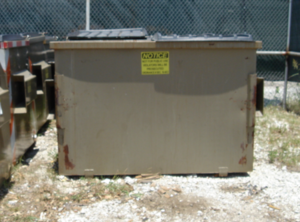
Dumpsters may contain materials that are direct sources of bacteria and pathogens (e.g. diapers, pet waste bags) and may attract wildlife that contribute bacteria and pathogens. Leaking dumpsters can therefore be a source of bacteria to the stormwater system. Concentrations of bacteria are typically very high from dumpsters, particularly from dumpster washdowns, which can constitute an important dry weather source of bacteria.
Practices to reduce bacteria from dumpsters include the following.
- Inspect dumpsters and compactors regularly for leaks (at least once a month)
- Inspect dumpster and compactor area regularly for litter or stains (at least once a week).
- Replace leaking dumpsters, waste containers, and compactors as soon as possible (call your waste management contractor or dumping leasing company for a replacement). Consider getting leak proof dumpsters.
- Control litter by making sure waste is contained in dumpsters and compactors. Sweep loading dock area regularly.
- Avoid or minimize placing liquid waste, grease, or leaky garbage bags into dumpsters. Place liquid waste in appropriate containers for disposal.
- Keep dumpster lids tightly closed to keep out rainwater and prevent leakage. Replace damaged or missing lids.
- Avoid hosing out the dumpster interior. Apply absorbent materials (kitty litter) over any liquids spilled in the dumpster.
- Post signs that indicate what materials can be placed in the container. Check regularly for non-accepted materials.
- Keep dumpsters and compactors in a covered area.
- Drain the area around the dumpster to the sanitary sewer system (Important note: drains cannot be open to the sky).
- Install berms or curbs around dumpsters and loading docks to contain leaks, spills, and trash. Collect any wash water with a wet vacuum system.
- Install a water quality management device to treat runoff from the dumpster area
- Expand education and outreach program for restaurant and store operators
For more information see [23], [24], [25], and [26].
Other Human Sanitary Sources - Trash cans
Information coming soon
Other Human Sanitary Sources - Garbage trucks
Information coming soon
Domestic pets - Dog parks
Dog parks represent an obvious potential source of bacteria and pathogens. Recommended practices for minimizing bacteria loading from dog parks include the following.
- Locate parks away from receiving waters
- Ensure parks are on pervious surfaces
- Drainage should be away from impervious areas
- Design parks to minimize compaction
- Enforce pickup of pet waste, including ensuring appropriate disposal facilities
- Possible design considerations for dog parks include doggy loos (disposal units installed in the ground to facilitate decomposition, pooch patches (areas of sand), and long grass areas that are mowed less frequently (a height of around 10 cm is appropriate).
- Siting dog parks out of swales and away from steep slopes
- Providing vegetated buffers of prescribed widths between dog parks and waterways, swales, storm drain inlets, gulleys and steep slopes
- Rimming the downslope edge(s) of dog parks with conventional BMPs that show promise at removing bacteria (e.g., infiltration-dependent facilities).
For more information, see [27], [28], [29], and [30].
Domestic pets - Dogs, cats, etc. residential
Information coming soon
Urban wildlife - Rodents/vectors
Information coming soon
Urban wildlife - Birds/bird congregation areas (gulls, geese, pigeons)
Information coming soon
Urban wildlife - Open space
Information coming soon
Other urban sources - Landfills
Information coming soon
Other urban sources - Food processing facilities
Information coming soon
Other urban sources - Outdoor dining
Information coming soon
Other urban sources - Restaurant grease bins
Information coming soon
Other urban sources - Bars/stairwells (washdown areas)
Information coming soon
Other urban sources - Road construction
Information coming soon
Other urban sources - Piers/docks
Information coming soon
Urban non-stormwater discharges - Power washing
Information coming soon
Urban non-stormwater discharges - Car washing
Information coming soon
Urban non-stormwater discharges - Pools/hot tubs
Information coming soon
Urban non-stormwater discharges - Reclaimed water/gray water
Information coming soon
Recreational sources - Bathers/boaters
Information coming soon
Recreational sources - RVs (mobile)
Information coming soon
Agricultural sources - Livestock/manure storage
Information coming soon
Agricultural sources - Livestock, pasture
Information coming soon
Agricultural sources - Livestock, corrals
Information coming soon
Agricultural sources - Livestock (CAFOs)
Information coming soon
Agricultural sources - Manure spreading
Information coming soon
Agricultural sources - Municipal biosolids reuse
Information coming soon
Agricultural sources - Reclaimed water/gray water
Information coming soon
Agricultural sources - Irrigation tailwater
Information coming soon
Agricultural sources - Slaughterhouses
Information coming soon
Other sources - Grazing
Information coming soon
Other sources - Streambank erosion
Information coming soon
Other sources - Wildlife populations
Information coming soon
Other sources - Other (describe in notes)
Information coming soon
